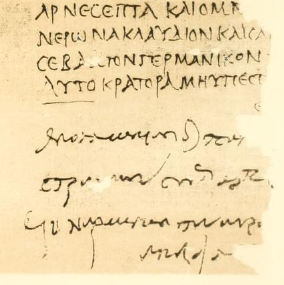Papyrus Oxyrhynchus 210 is an early Christian fragment, written in Greek. It was discovered in Oxyrhynchus. The manuscript was written on papyrus in the form of a codex. It is dated to the third century. Currently it is housed in the Cambridge University Library (4048) in Cambridge.
Papyrus Oxyrhynchus 212 consists of three fragments of a comedy of Aristophanes, written in Greek. It was discovered in Oxyrhynchus. The manuscript was written on papyrus in the form of a roll. It is dated to the first or second century. Currently it is housed in the British Library in London.

Papyrus Oxyrhynchus 213 consists of two fragments of a tragedy by an unknown author, written in Greek. It was discovered in Oxyrhynchus. The manuscript was written on papyrus in the form of a roll. It is dated to the second century. Currently it is housed in the British Library in London.
Papyrus Oxyrhynchus 223 is a fragment of Homer's Iliad (E,329-705), written in Greek. It was discovered in Oxyrhynchus. The manuscript was written on papyrus in the form of a roll. It is dated to the third century. Currently it is housed in the Bodleian Library in Oxford.
Papyrus Oxyrhynchus 228 is a fragment of the Laches, a dialogue of Plato, written in Greek. It was discovered in Oxyrhynchus. The manuscript was written on papyrus in the form of a roll. It is dated to the second century. It is housed in the Bodleian Library in Oxford.
Papyrus Oxyrhynchus 229 is a fragment of the Phaedo, a dialogue by Plato, written in Greek. It was discovered in Oxyrhynchus. The manuscript was written on papyrus in the form of a roll. It is dated to the second or third century. Currently it is housed in the British Library in London.
Papyrus Oxyrhynchus 231 is a fragment of the De Corona by Demosthenes, written in Greek. It was discovered in Oxyrhynchus. The manuscript was written on papyrus in the form of a roll. It is dated to the second or third century. Currently it is housed in the Cambridge University Library in Cambridge.
Papyrus Oxyrhynchus 236 consists of three fragments concerning Ptolemy Neos Dionysus (Auletes), written in Greek. They were discovered in Oxyrhynchus. The manuscript was written on papyrus in the form of a sheet. It is dated to the 1st century BC. Currently it is housed in The British Library.
Papyrus Oxyrhynchus 240 is a declaration by a village scribe, written in Greek. It was discovered in Oxyrhynchus. The manuscript was written on papyrus in the form of a sheet. It is dated 11 February 37. Currently it is housed at the British Library in London.
Papyrus Oxyrhynchus 245 is a fragment describing the registration of some cattle, written in Greek. It was discovered in Oxyrhynchus. The manuscript was written on papyrus in the form of a sheet. It is dated to 26 January 26. Currently it is housed in the University of Pennsylvania in Philadelphia.
Papyrus Oxyrhynchus 248 is a fragment of a registration of some property, written in Greek. It was discovered in Oxyrhynchus. The manuscript was written on papyrus in the form of a sheet. It is dated to 10 October 80. Currently it is housed in the Cambridge University Library in Cambridge.
Papyrus Oxyrhynchus 261 is a fragment of an Appointment of a Representative, in Greek. It was discovered in Oxyrhynchus. The manuscript was written on papyrus in the form of a sheet. It is dated to 55-56. Currently it is housed in the British Library in London.
Papyrus Oxyrhynchus 264 is a fragment of a Sale of a Loom, in Greek. It was discovered in Oxyrhynchus. The manuscript was written on papyrus in the form of a sheet. It is dated to 8 August 54. Currently it is housed in the Cambridge University Library in Cambridge.
Papyrus Oxyrhynchus 267 is a fragment of an Agreement of Marriage in Greek. It was discovered in Oxyrhynchus. The manuscript was written on papyrus in the form of a sheet. It is dated to 22 May 37. Currently it is housed in the Milton S. Eisenhower Library of the Johns Hopkins University in Baltimore.
Papyrus Oxyrhynchus 274 is a fragment of a Register of Property, in Greek. It was discovered in Oxyrhynchus. The manuscript was written on papyrus in the form of a sheet. It is dated to 28 August 97. Currently it is housed in the Union Theological Seminary in New York City.
Papyrus Oxyrhynchus 284 is a fragment of an Extortion by a Tax-Collector, in Greek. It was discovered in Oxyrhynchus. The manuscript was written on papyrus in the form of a sheet. It is dated to the year about 50. Currently it is housed in the Houghton Library of the Harvard University in Cambridge.
Papyrus Oxyrhynchus 291 is a fragment of a Letter of a Strategus, in Greek. It was discovered in Oxyrhynchus. The manuscript was written on papyrus in the form of a sheet. It was written between 25–26. Currently it is housed in the British Library in London.
Papyrus Oxyrhynchus 292 is a fragment of a Letter of Recommendation, in Greek. It was discovered in Oxyrhynchus. The manuscript was written on papyrus in the form of a sheet. It was written about 25. Currently it is housed in the Cambridge University Library in Cambridge.
Papyrus Oxyrhynchus 298 is a fragment of a Letter of a Tax-Collector, in Greek. It was discovered in Oxyrhynchus. The manuscript was written on papyrus in the form of a sheet. It was written in the first century. Currently it is housed in the library of the Princeton University in Princeton.
Papyrus Oxyrhynchus 237 consists of a fragment of Petition of Dionysia to the Praefect, written in Greek. They were discovered in Oxyrhynchus. The manuscript was written on papyrus in the form of a roll. It was written after 27 June 186. Currently it is housed in the Bodleian Library.

